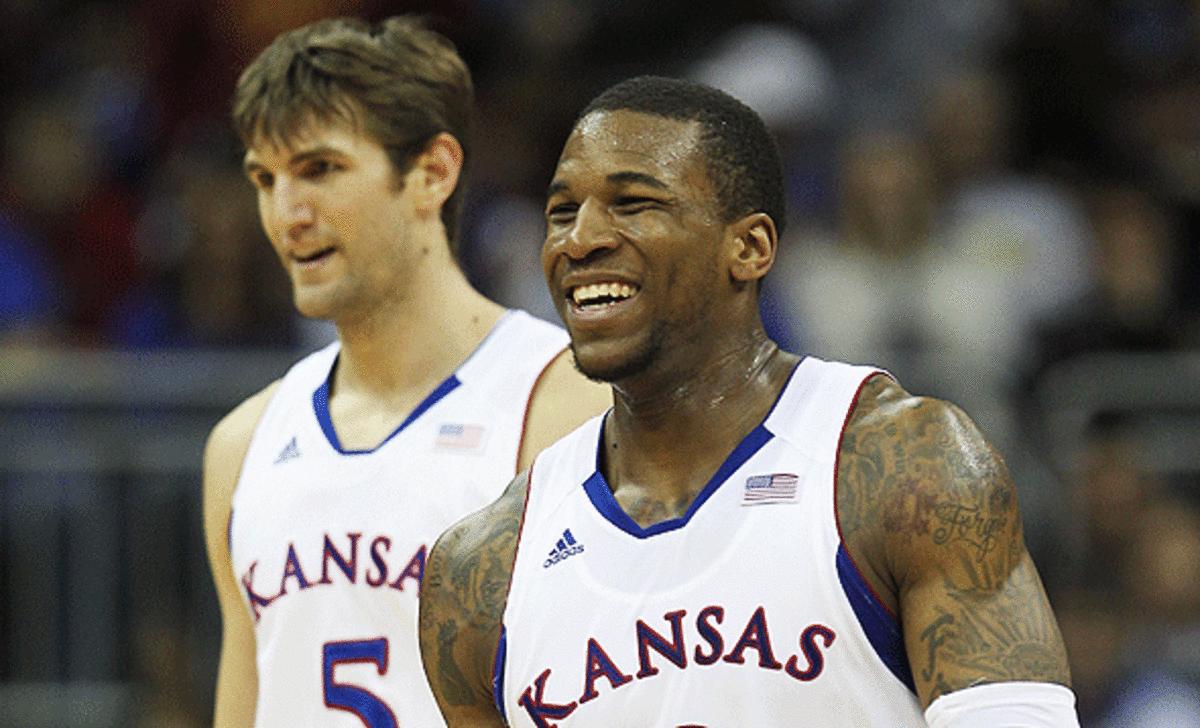Leveraging Lineups: KU's Key Combos

To beat OSU, Kansas needs to milk a few more possessions out of Jeff Withey and Thomas Robinson. (Jamie Squire/Getty Images)

NEW ORLEANS -- Kansas is not favored to win its Final Four game, and Las Vegas has assigned it the third-lowest championship odds of the remaining teams. But the gap between KU and Ohio State is just three points, according to kenpom.com's efficiency-based projections, and the gap between KU and Kentucky would only be two possessions. By playing slightly above themselves, the Jayhawks could win this thing. It may just be a matter of leveraging their best lineups. Let's take a look at the data:
The Carolina Sample
KU's 80-67, Elite Eight win over North Carolina was a 70-possession game. All-America power forward Thomas Robinson and center Jeff Withey played 35 possessions of defense together; for the other 35 possessions, just one of them was on the floor.
On the 35 Robinson-Withey possessions, the Tar Heels averaged 0.74 points per possession.
On the other 35 possessions, UNC averaged 1.17 PPP. To put this in context: Had Carolina's offense played the entire game at its Withey-Robinson rate, it would have scored just 52 points. Had Carolina's offense played the entire game at its other rate, it would have scored 82 points.
To put it in a different context: Against the Withey-Robinson combo, Carolina's offense scored at a Towson-like level. As in, a worst-in-Division-I level. When Carolina's offense faced just one of KU's two posts, it scored at a Kentucky-like level. As in, a second-best-in-D-I level.
Does It Hold Up?
On court/off court data from a single game shouldn't be used to make large-scale conclusions. Season-long play-by-play data can be more revealing, though, and I mined through a file of approximately 75 percent* of Kansas' 2011-12 season to look at various lineup efficiencies.
On the season, Robinson averages 31.6 minutes per game and Withey averages 24.4. In this sample, they were on the floor together 44.8 percent of the time, and Kansas' efficiency margin (+0.24) was twice as good as it was for all other lineup combinations:
The defensive gap is not as wide as it was in the Carolina game, but believe me: the difference between a team with a +0.24 efficiency margin and a +0.12 margin is immense. A team with a +0.24 margin is a title contender.
(* Clean play-by-play data in which full 10-man lineups could be identified was not available for the entire season -- but I believe the 75-percent sample, which includes more than 1,000 minutes of game time, to have value. It is raw data that has not been adjusted for competition.)
What It Means
I realize that stating, "Kansas is better with Robinson and Withey on the floor together," is not earth-shattering. One is a National Player of the Year candidate, and the other is one of the country's elite shot-blockers. Nor, I am aware, is it possible for the duo to be subbed in and out of the game together. Kansas lacks any big bench bodies -- Kevin Young and Justin Wesley cannot play the five-spot -- and so if Robinson's out, Withey needs to be in, and vice versa.
The point is that if the Jayhawks can find a way to milk a few more possessions than average -- even just 5-10 -- out of the Robinson-Withey lineup, it would significantly increase their odds of knocking off Ohio State. And if they were to similarly lean on that lineup against (most likely) Kentucky in the title game, they might have a chance of pulling off that upset, too.
The Off-Ball Combos
Kansas uses three-guard lineups at nearly all times, with Tyshawn Taylor handling the point-guard duties. That leaves three potential combinations at the 2-3 spots, the most common of which is starters Elijah Johnson and Travis Releford, who played 60.7 percent of minutes together in my play-by-play sample. The Johnson-Releford combo, however, was the worst of the three:
